Grocery prices continue to fluctuate, but some foods are expected to see particularly steep increases in 2025. Factors like supply chain disruptions, climate issues, and global economic changes are driving these price hikes. While inflation has slowed in some areas, certain food categories remain vulnerable to rising costs. Keeping an eye on these trends can help you budget wisely and stock up before prices soar. Here are seven foods that are projected to become more expensive this year.

Image Source: Pexels
1. Eggs
Egg prices have been volatile in recent years, and 2025 looks to continue the trend. The avian flu outbreak has led to major losses in poultry farms, limiting supply and pushing costs higher. Farmers are struggling to rebuild their flocks, and production shortages mean consumers will likely see price hikes at grocery stores. In December 2024, the national average price for a dozen eggs was $4.15, with predictions of a further 20% increase this year. Shoppers looking to save may want to explore alternative sources like local farms or egg substitutes.
2. Dairy Products
Milk, cheese, and butter are all facing price increases due to higher feed costs and labor shortages in the dairy industry. Many farms are also dealing with extreme weather conditions that are affecting production. Additionally, transportation and processing costs have risen, further contributing to the increased prices of dairy products. Consumers may notice that even store-brand dairy items are creeping up in cost as these issues persist. To save money, consider buying in bulk, looking for store promotions, or trying plant-based milk alternatives, which often have more stable pricing.
3. Processed Foods
Prices for processed foods, such as frozen meals, snack foods, and canned goods, have remained high since the pandemic. Experts predict they will not return to pre-pandemic levels anytime soon. Rising costs of ingredients, packaging, and transportation continue to drive prices upward. Manufacturers are also shrinking package sizes while keeping prices the same, a tactic known as shrinkflation. Consumers should compare unit prices, buy in bulk when possible, and look for discounts or coupons to combat these increases. Preparing homemade meals instead of relying on packaged foods can also help reduce grocery expenses.
4. Meat Products
Meat prices, particularly for beef and pork, are expected to rise due to multiple factors. Factors include increased feed costs, droughts affecting livestock, and supply chain disruptions. Farmers are paying more to raise and transport animals, and those costs are being passed down to consumers. Some grocery stores have already reported higher beef prices, with further hikes expected later in the year. Shoppers can save by buying meat in bulk, looking for markdowns, or incorporating more plant-based proteins into their diets.
5. Fresh Produce

Image Source: Pexels
While some fruits and vegetables may remain affordable, others are becoming more expensive due to climate-related challenges. Extreme weather events, such as droughts and floods, are affecting crop yields and limiting supply. Additionally, higher transportation costs and proposed tariffs are making it more expensive to ship fresh produce. Items like avocados, berries, and leafy greens have already seen price increases in some regions. Shopping seasonally, visiting local farmers’ markets, and considering frozen alternatives can help keep costs manageable.
6. Seafood
Seafood prices are projected to rise due to overfishing concerns, supply chain issues, and environmental regulations aimed at sustainability. Reduced fish populations and stricter quotas mean there is less available seafood, which drives up costs. Imports of seafood are also facing increased tariffs and transportation fees, making certain varieties even more expensive. Consumers who enjoy seafood may need to seek out budget-friendly alternatives like frozen or canned options.
7. Coffee
Coffee lovers may need to brace for higher prices as global supply struggles to meet demand. Climate change has led to unpredictable growing conditions in major coffee-producing regions, reducing yields and driving costs up. Additionally, labor shortages and increased shipping costs are adding to the price hikes. Many brands have already raised prices, and experts predict further increases throughout the year. To save, consider buying coffee in bulk, switching to store brands, or using cashback rewards and coupons when making a purchase.
Grocery prices are constantly shifting, and these seven foods are likely to become more expensive in 2025. By staying informed and adjusting your shopping habits, you can still manage to save money despite these rising costs. Stocking up during sales, exploring alternative products, and using coupons or cash-back programs can all help stretch your grocery budget. While food prices may be on the rise, smart shopping strategies can ensure you get the most value for your money.
Read More


